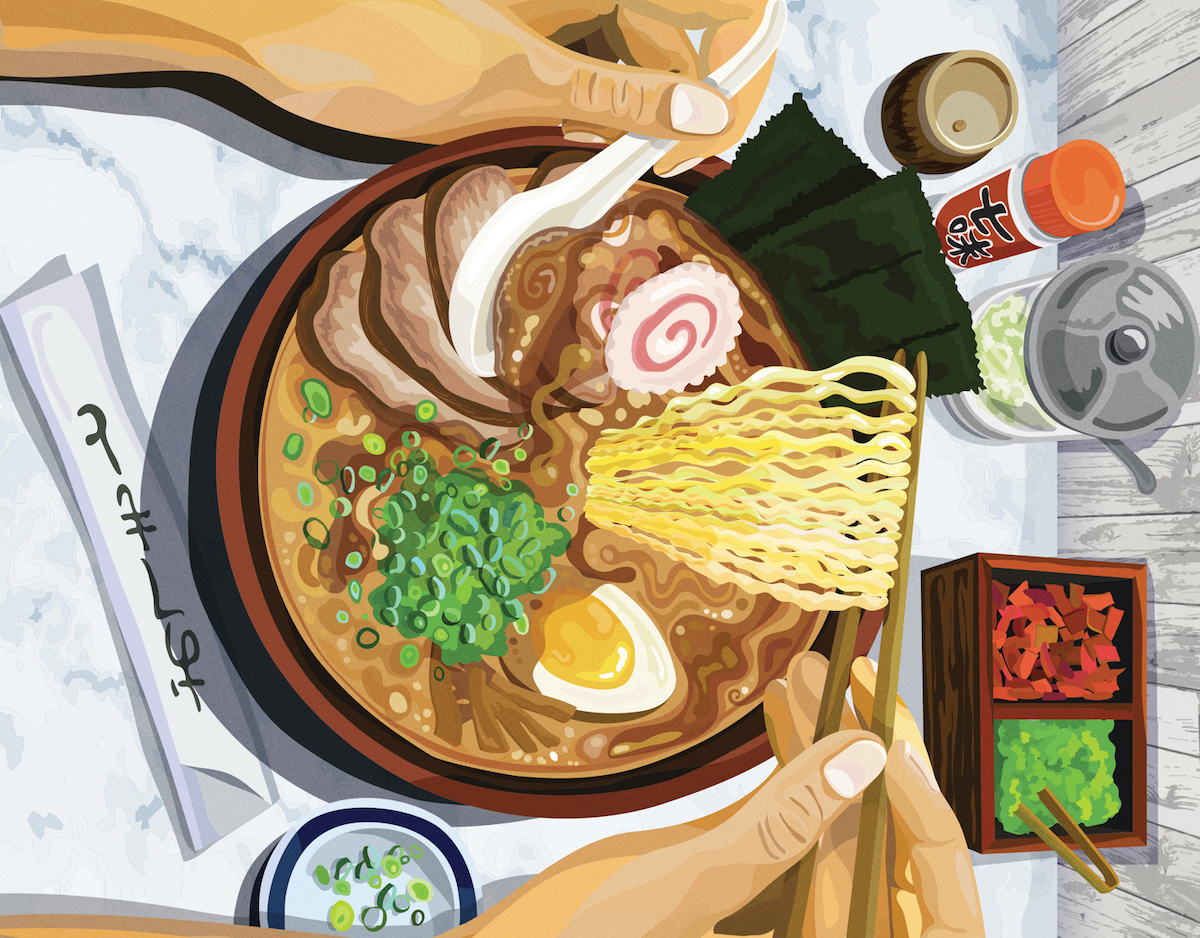
Ruminating Over Ramen
Illustration by Anna Takahashi
The make-up of the perfect bowl.
Why have Chefs Mateo Rogers and Brittney Yracheta been obsessing over the perfect bowl of ramen? Because this creative team behind Heirloom Catering is about to open Momotaro, their Paso Robles ramen shop.
For Mateo, this new venture recalls his roots. His grandmother, an Okinawa native, often read him the revered Japanese children’s story, Momotaro (The Peach Boy). “It brought me a lot of comfort,” he recalls.
Though that time-honored tale features dumplings, not ramen, the sentiment is still close at hand. “Ramen is a Japanese comfort food, and certainly always has been for me,” Mateo explains. “We want our guests to experience that with a perfect bowl of ramen, to experience the nuance every bowl provides.”
Building The Perfect Ramen Bowl
Perfect ramen starts with spot-on broth, and there certainly won’t be a seasoning packet in sight at Momotaro. The key to this broth will be prized bones from Kurobuta. The breed is an offshoot of Berkshire pigs, often described as the waygu of the pork world.
For their basic broth, Chefs Mateo and Brittney will make tonkotsu, the Japanese word translating to pork bones in English. “Some of the best tonkotsu is simply just that — pork bones and water,” says Mateo. “Our approach will be the same.”
Simplicity doesn’t mean quick, however. This broth will be on a high simmer for at least 15 hours, a process that insistently coaxes the bones to release their collagen. The resulting rich, milky broth is a signature element of traditional tonkotsu.
As for noodles, the chefs are still deciding. That’s a process far more complex than most would imagine, since the options are as varied as the regions of Japan. Shapes range from skinny and straight to thick and wavy, while flour possibilities include rice, buckwheat and wheat.
To launch their ramen adventure, the couple will source from Sun Noodle, a craft producer in Los Angeles. Clearly, these won’t be just any noodles.
“We’ll take our broth to them, and they’ll assist us in creating the perfect noodle for our tonkotsu,” Mateo continues. “We’re leaning towards a straight thin noodle as our staple ramen, in the style of Hakata (a region of Japan renowned for its ramen).”
He adds that “once we’re open in our space and comfortable, we will look into producing our ramen noodles in-house. We’ll use wheat flour for our base and kansui (alkaline mineral water), which gives the noodles a chewy mouth feel and distinct texture.”
Not surprisingly, toppings for the ramen bowls need the same meticulous treatment as the broth and the noodles.
“Like any food pairing, the toppings are there for a specific reason,” Brittney notes, “whether it be beni shōga (pickled ginger) to offer some acidity to cut through a rich broth, or butter and corn that pairs perfectly with a shoyu (soy-based) broth.”
Rules of Ramen
Given all the time and effort that have gone into creating the perfect ramen bowl for Momotaro, now it’s time for you to do your part — consume it. In doing so, follow these four essential ramen rules from the chefs:
One: Sample the painstakingly prepared broth first, and taste it for what it is. Allow it to seduce you, and take over your senses. Drinking from the bowl is perfectly acceptable.
Two: Slurp like your life depends on it! Slurping not only cools down the noodles and broth, but it also aerates the broth and opens up all the aromas hiding within. Don’t worry about who’s next to you; this affair is between you and your ramen bowl.
Three: Partake of the ramen as soon as it’s placed in front of you. It is best enjoyed when it’s as hot as possible temperature-wise. Eating it slowly or waiting to eat it causes the noodles to overcook, and who wants limp noodles?
Four: This rule is important and refers back to Rule One. Unless you’re a regular customer, don’t add any extra toppings or sauces to your ramen until you’ve tried it. That’s like slapping the chef in the face. Once you’ve tried it, though, by all means feel free to embellish it.

